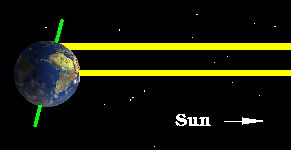Season’s reasons
Unless
you live near the Earth's equator, you have no doubt noticed that the weather
changes during the year: it is hotter during the summer, colder in winter, and
somewhere in between during spring and fall. These are the seasons, a regular
change in temperature, that repeat them every year, more or less regularly.
What
causes these changes? The Sun is our main source of heat, and since these
changes are the same every year, it surely has something to do with the
movement of the Earth around the Sun. If we get closer to a fire, we get
hotter. Could it be then that the Earth gets closer to the Sun during summer
and farther during winter? This idea
seems at first to have some merit, until we remember that the seasons get
reversed when we cross the equator: when it is summer in the northern
hemisphere, it is winter in the southern one, and vice versa. And surely
Argentina is at the same distance from the Sun as the USA!
Besides,
that the Earth's orbit is an ellipse, not a circle, so that at some times the
Earth is closer to the Sun than at others; but this ellipse is very nearly a
circle, and the relatively small differences in distance to the Sun cannot
account for the changes in temperature. And to make things worse, the Earth is
closer to the Sun during the northern hemisphere winter!
What,
then, is the cause of the seasons?
In
the above animation, you can see the Earth during one full year (the animation
then starts over again), as you would if you looked straight at it from the
Sun. As you can see, the part of the Earth that is directly facing the sunchanges with the time of the year. It is the northern half for a while, then
moves south of the equator, only to move back to the north again.
What
causes this? The Earth rotates around an imaginary line passing through the
poles, called the axis. This line forms an angle of 23.4° with the
perpendicular to the orbit of the Earth around the Sun.
What
has this to do with temperature? Well, when the northern hemisphere is leaning
away from the sun, the rays coming from it hit this part of the Earth at a
smaller angle than on other parts of the world. This means that the same amount
of light is distributed over a larger surface, and therefore these places
receive less heat than the others. The southern hemisphere is experiencing summer,
the northern hemisphere winter. In half a year, the situation reverses, and it
is now winter in the southern hemisphere since that part of the earth is now
leaning away from the sun.
The
seasons are then the result of this tilt of the Earth's axis. If the tilt of
the Earth's axis was 0° there would be no difference in how the rays from the
sun hit its different regions, and there would be no seasons.
AVE Beach Resort
Veerabagupathy,
Chothavilai beach,
Thengamputhoor,
Kanyakumari.
Call
Tel No: 04652 221337
+91 8220099080
Email: aveholidayhome@gmail.com



No comments:
Post a Comment